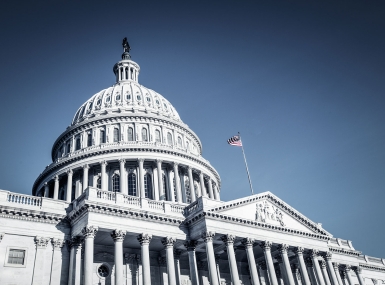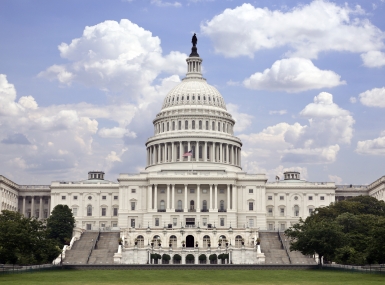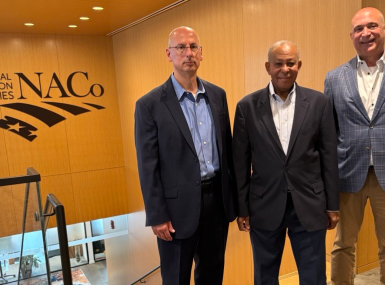Congress seeks input on tribal land-to-trust issues
 Photo by Charles Taylor
Photo by Charles Taylor
Susan Podziba (center), a public policy mediator, listens to Randy Noka (l) of the Narragansett Indian Tribal Council. On his right is Brian Cladoosby, president of the National Congress of American Indians.
After years of negotiations, the Lytton Band of Pomo Indians and Sonoma County, Calif. have reached an agreement that would enable the tribe to develop housing, a winery and hotel on tribal land in the county. "In Sonoma County, there are five federally recognized tribes," Supervisor David Rabbit told a recent Capitol Hill roundtable, convened by Sen. John Barrasso (R-Wyo.), chairman of the Senate Indian Affairs Committee. "We have three intergovernmental agreements with those tribes that have worked very, very well," Rabbit added. Nationwide, there are 566 federally recognized Indian tribes. More notice and more county-tribal collaboration are what NACo and California counties want when the federal government takes Indian lands into trust that are later developed by the tribes. The U.S. government holds the legal title to tribal trust lands, and the tribe holds the beneficial interest. The deal in Sonoma was successful for the county and the tribe, but elsewhere similar issues have been more contentious since the U.S. Supreme Court's 2009 Carcieri v. Salazar decision. The high court ruled that the secretary of the interior has no authority to take lands into trust for tribes not federally recognized by the Indian Reorganization Act of 1934. Barrasso's roundtable sought to gather more information, on both sides of the issue, for his committee. "I am looking for a new beginning, and today's dialogue is a good start," he said. Indian nations want Congress to come up with a legislative "Carcieri fix" that would nullify the effects of the Supreme Court decision and focus exclusively on the Interior Department's ability determine tribal status and add to Indian land holdings. However, NACo, the California State Association of Counties (CSAC) and others, want any Carcieri fix to be more comprehensive and deal with "problems" in Interior's trust land acquisition process by giving localities more leverage to negotiate with tribes and requiring earlier notice from the Bureau of Indian Affairs (BIA) about tribal acquisition and development plans. Representatives of the United South and East Tribes, the National Congress of American Indians and other tribal officials also gave their views. Rabbit explained that the agreement reached with the Pomo Indians in Sonoma outside of the federal process will require the tribe to pay the county $6.1 million to mitigate effects of the development of a 200,000-case winery, 200-room hotel and homes. In a recent CSAC brief on Indian Fee to Trust Reform, the sta te association said counties should receive information equivalent to the public information required for planning, zoning and permitting at local levels. Currently, Rabbit said, counties are consulted only about decreased local tax revenue and conflicts over who has jurisdiction. Last month, Sonoma County supervisors passed a resolution noting that "large tribal development projects, including casinos, can attract large volumes of visitors and lead to a myriad of significant adverse social and environmental impacts on the surrounding community." Napa County Supervisor Diane Dillon also spoke at the Capitol Hill listening session. "We're not about telling tribes what they can do so much as dealing with the mitigation and the impact from what happens off tribal land," she said. Tribal officials, while willing to work with localities, say the Indian Reorganization Act has served them well for 70 years, with some exceptions, and is the basis of the federal obligation to restore "stolen" Indian land. Chief Kirk Francis of the Penobscot Indian Nation said that in 1980, the Penobscots had a 12-million-acre land claim in Maine, encompassing about two-thirds of the state. Today tribal holdings are about one-quarter million acres. "The whole idea of the land-to-trust process, in my mind, is regaining our ancestral territory that is at the very core of our culture and beliefs," he said, "but it also provides the ability within those territories to create quality of life for real people." Excerpted relevant NACo policy
NACo policy supports government-to-government relations that recognize the role and unique interests of tribes, states, counties and other local governments to protect all members of their communities and to provide governmental services and infrastructure beneficial to all Indian and non-Indian alike .
The association also supports improvement of the process by which lands are considered to be taken into trust such as revising the Indian Reorganization Act of 1934 to require adequate advance notice of applications, actual meaningful consultation (including providing counties 120 days to respond to applications and requiring the Department of the Interior/Bureau of Indian Affairs to respond within 90 days, in writing, to such comments explaining the rationale for acceptance or rejection of those comments) and (to the extent constitutionally permissible) the consent of the affected counties .
NACo opposes administrative action or a legislative "quick fix" to overturn the U.S. Supreme Court's Carcieri v. Salazar decision
Carcieri decision in brief
The U.S. Supreme Court's ruling in Carcieri v. Salazar has been described as a "landmark" ruling. In essence, the 2009 decision says the secretary of the interior cannot place land into trust for Indian tribes that weren't federally recognized when the Indian Reorganization Act (IRA) was passed in 1934.
It began as a dispute between the Narragansett Indian Tribe and local governments in Rhode Island. The tribe sought to build housing for the elderly on 31 acres of land that the U.S. Interior Department had taken into trust for tribal use.
The state of Rhode Island (whose governor at the time was Donald Carcieri) sued the Interior Department, alleging that then-Interior Secretary Ken Salazar had no authority to grant the land trust status.
Rhode Island argued that the Narragansetts were under the Guardianship of the Colony of Rhode Island in 1709. The tribe subsequently relinquished its tribal authority and sold all but two acres of its land. From 1927 to 1937, federal authorities considered the tribe to be under state jurisdiction, and hence, not federally recognized in 1934. The high court concurred.
Attachments
Related News

NACo sends letter to congressional appropriations committees urging federal investments in county government activities
On July 9, NACo sent a letter to leaders of the U.S. House and U.S. Senate Appropriations Committees urging them to adequately fund key federal programs of importance to counties in the Fiscal Year (FY) 2026 discretionary appropriations bills.

U.S. Congress passes reconciliation bill: What it means for counties
On July 3, the U.S. Congress passed sweeping budget reconciliation legislation.

County officials voice concern for SNAP, Medicaid amid reconciliation vote
Ahead of the Senate and House's budget reconcilliation votes, county officials from five states traveled to Capitol Hill June 24, to advocate against its provisions related to the social safety net programs.
